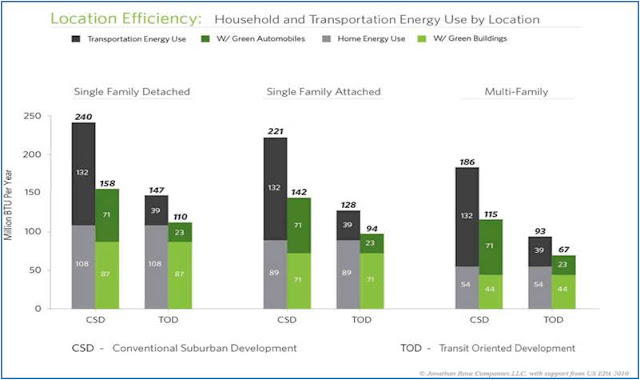Much residential "green building" attention has been placed on material selection, alternative power sources, and mechanical efficiencies. These choices all play a role in building "green", but arguably, none of these charismatic green features are as important as the energy efficiency gains achieved through building and living in smaller spaces.
Smaller houses can take many forms, and the three common forms that I'll mention in this post, all achieve notable reductions in terms of their environmental lifecycle impact reductions: Multi-family, ADU, and "Tiny Houses"
Let's begin with the recent EPA-sponsored report about the energy impacts of residential housing choices. As stated on the introductory page,
"Buildings and transportation together account for about 70 percent of energy use in the United States and are responsible for about 62 percent of U.S. greenhouse gas emissions"
The findings in this report illustrate that certifiably green buildings are not as significant in reducing that energy as where you build (Conventional Suburban Development or Transit Oriented Development) and the housing type (Single Family Detached, Single Family Attached, and Multi-Family). The report findings are summarized well in this rich graphic.
For me, I’m beholden to my innate desire to design and build something on my own terms. There are strong correlations between the size of average Single Family Detached, Single Family Attached, and Multi-Family homes. However, the impact of housing size perhaps has a more direct correlation to energy use than those building type descriptions.
From 1950, to 2008, the average sq ft per person has increased from 259 ft to 961 ft, a 372% increase.

From 1950, to 2008, the average sq ft per person has increased from 259 ft to 961 ft, a 372% increase.

ADU’s are an accessible way for urban homeowners to make a big stand on issues that span community building, environmentalism, urbanism, and climate change. Done well, ADU’s present a compelling personal financial opportunity for individuals to create a regenerative, personal financial portfolio. I plan to discuss the economics of my ADU and ADUs at large in future posts.

I have extracted some graphics from a presentation about the findings from the Oregon DEQ report, "Life Cycle Approach to Prioritizing Methods of Preventing Waste from the Residential Construction Sector in the State of Oregon". I anticipate this this groundbreaking report will prove to be pivotal in the green building movement and will help to instigate a shift toward an emphasis on living smaller.

I have extracted some graphics from a presentation about the findings from the Oregon DEQ report, "Life Cycle Approach to Prioritizing Methods of Preventing Waste from the Residential Construction Sector in the State of Oregon". I anticipate this this groundbreaking report will prove to be pivotal in the green building movement and will help to instigate a shift toward an emphasis on living smaller.
I believe ADU’s will naturally become more and more popular where there is sufficient housing demand and where they are allowed by zoning laws. With a few exceptions in the US, ADU’s are not legal.
The first ten minutes of this video is of Jay Shafer of Tumbleweed Tiny Houses addressing code barriers to small housing. Jay Shafer is the person who has popularized the notion of building tiny houses on wheels- which, as he explains, is simply a tactical exploitation of a common municipal zoning loophole to legitimize what would otherwise be illegally constructed tiny houses.




